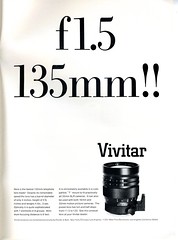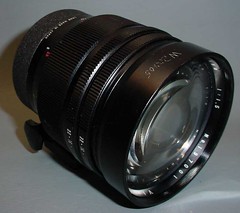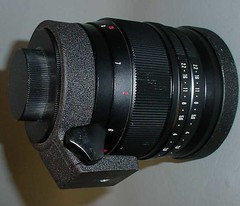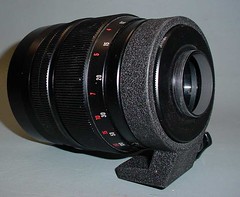Difference between revisions of "Vivitar Professional 135mm f/1.5"
Steevithak (talk | contribs) m (→Specifications) |
(touch-up) |
||
| Line 9: | Line 9: | ||
}} | }} | ||
=Description= | =Description= | ||
| − | Vivitar Professional | + | "Vivitar Professional" was a name applied to only a few, rare lenses marketed by [[Vivitar|Ponder & Best (aka Vivitar)]]. This badge follows the "P&B Vivitar" badged lenses and precedes the more common "Vivitar" branding. The Vivitar Professional 135mm f/1.5 lens is highly sought after by collectors and generally fetches a very high price in auctions due to its rarity. Reviews of the quality of the lens vary. The identity of the manufacturer is unknown; however, the lens is marked "Made in Japan". It is not known how many were produced but second-hand accounts of total production numbers vary from under 100 units to a number in the low hundreds. Only a handful of existing examples are currently documented (see serial number list below for those that are known). |
| − | + | The lens was produced in 1967-1968, originally for NASA. It retailed for just under $600 USD. According to a review published in a 1967 issue of ''Camera 35'' magazine, the lens intentionally sacrifices resolving power to gain the extra two stops over an f/2.8 lens but the result is better than that from shooting at f/2.8 and pushing development by two stops. A quote from the article: | |
| − | <blockquote>This is no general purpose lens. First, It's huge - five inches long, four inches wide, weighing a hefty four pounds, eight ounces. Second, it's pre-set. But this should present no problem, since you'd be foolish to use (and pay the price for) a lens specifically designed for speed at any but its widest apertures. A lens with this much glass area gives less than optimum performance under a bright sun, due to inevitable flare. Even inside use a lens hood. Mechanically, this Vivitar is superb. But this is to be expected, since the lens was originally made for NASA, to rigid government specifications.<ref>Camera 35, Aug/Sep 1967, | + | <blockquote>This is no general purpose lens. First, It's huge - five inches long, four inches wide, weighing a hefty four pounds, eight ounces. Second, it's pre-set. But this should present no problem, since you'd be foolish to use (and pay the price for) a lens specifically designed for speed at any but its widest apertures. A lens with this much glass area gives less than optimum performance under a bright sun, due to inevitable flare. Even inside use a lens hood. Mechanically, this Vivitar is superb. But this is to be expected, since the lens was originally made for NASA, to rigid government specifications.<ref>''Camera 35,'' Aug/Sep 1967, page 57.</ref> |
</blockquote> | </blockquote> | ||
| − | + | Modern users of the lens confirm that the result is soft when the lens is shot wide open, but its primary value now is as a collectors' item. | |
=Specifications= | =Specifications= | ||
Revision as of 05:41, 4 January 2012
The Vivitar Professional 135mm f/1.5 lens is a rare telephoto lens marketed by Ponder & Best.

|
| Vivitar Professional 135mm f/1.5 lens image by Vilhelm Sjostrom (Image rights) |
Description
"Vivitar Professional" was a name applied to only a few, rare lenses marketed by Ponder & Best (aka Vivitar). This badge follows the "P&B Vivitar" badged lenses and precedes the more common "Vivitar" branding. The Vivitar Professional 135mm f/1.5 lens is highly sought after by collectors and generally fetches a very high price in auctions due to its rarity. Reviews of the quality of the lens vary. The identity of the manufacturer is unknown; however, the lens is marked "Made in Japan". It is not known how many were produced but second-hand accounts of total production numbers vary from under 100 units to a number in the low hundreds. Only a handful of existing examples are currently documented (see serial number list below for those that are known).
The lens was produced in 1967-1968, originally for NASA. It retailed for just under $600 USD. According to a review published in a 1967 issue of Camera 35 magazine, the lens intentionally sacrifices resolving power to gain the extra two stops over an f/2.8 lens but the result is better than that from shooting at f/2.8 and pushing development by two stops. A quote from the article:
This is no general purpose lens. First, It's huge - five inches long, four inches wide, weighing a hefty four pounds, eight ounces. Second, it's pre-set. But this should present no problem, since you'd be foolish to use (and pay the price for) a lens specifically designed for speed at any but its widest apertures. A lens with this much glass area gives less than optimum performance under a bright sun, due to inevitable flare. Even inside use a lens hood. Mechanically, this Vivitar is superb. But this is to be expected, since the lens was originally made for NASA, to rigid government specifications.[1]
Modern users of the lens confirm that the result is soft when the lens is shot wide open, but its primary value now is as a collectors' item.
Specifications
- Badging: Vivitar Professional
- Manufacturer: unknown
- Manufacture Date: 1967
- Focal Length: 135mm
- Aperture Range: f/1.5 - f/22 w/half-stops
- Diaphragm Type: preset
- Diaphragm Blades: 16
- Filter Diameter: 95mm
- Minimum Focus: 1.65 meters (5 feet, 5 inches)
- Mounts: T-mount
- Elements: 7
- Groups: 6
- Weight: 1,970g (2,170g with hood, tripod collar, and caps)
- Accessories: tripod mounting ring, and detachable metal hood
- Example Serial Numbers: 197012, 197001, 196811, 19671001 (no "Professional" badging or tripod ring), 1967197 (no tripod ring)
- Original Stock Number(s): unknown
Photos

|
| image by Vilhelm Sjostrom (Image rights) |

|
| image by Vilhelm Sjostrom (Image rights) |

|
| Vivitar 135mm f/1.5 ad image by Nesster (Image rights) |

|
| image by Reed Drummond (Image rights) |

|
| image by Reed Drummond (Image rights) |

|
| image by Reed Drummond (Image rights) |

|
| image by Reed Drummond (Image rights) |

|
| image by Reed Drummond (Image rights) |
References
- ↑ Camera 35, Aug/Sep 1967, page 57.
Links
- Vivitar Professional 135mm f/1.5 lens, Fred Miranda forum. Photos of the lens and taken with the lens.
- Vivitar Professional 135mm f/1.5 lens, Nikonians forum.
- Rangefinderforum.com: Vivitar Professional 135mm f/1.5 lens.
- Photo.net: Vivitar Professional 135mm f/1.5 lens.
- Manual Focus Lens Forum: Vivitar Professional 135mm f/1.5 lens - bad boy
- Manual Focus Lens Forum: Vivitar 200mm f/3.5 18 blade -- how old is (several posts discuss the 135mm f/1.5)